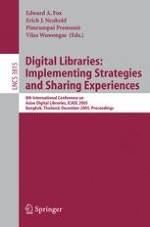2005 | Buch
Digital Libraries: Implementing Strategies and Sharing Experiences
8th International Conference on Asian Digital Libraries, ICADL 2005, Bangkok, Thailand, December 12-15, 2005. Proceedings
herausgegeben von: Edward A. Fox, Erich J. Neuhold, Pimrumpai Premsmit, Vilas Wuwongse
Verlag: Springer Berlin Heidelberg
Buchreihe : Lecture Notes in Computer Science
